Oil Spill Prevention, Control and Countermeasures
See UC San Diego's Spill Prevention, Control, and Countermeasure Plan.
SPCC Plan overview
Spills of any type of oil may damage the environment. UC San Diego has a campus-specific Spill Prevention, Control, and Countermeasure Plan (SPCC) to prevent or reduce the discharge of oil into navigable waters.
The campus SPCC plan identifies management measures that must be implemented wherever oil and oil-based products are used or stored to prevent spills and promptly respond to accidental releases.
A complete list of the types of oils and oil-based products that are covered by the plan, employee responsibilities, control measures, spill response procedures, and inspection and training requirements are provided below.
Report oil spills
Report any oil spill that cannot be completely contained and cleaned up, regardless of amount, if it discharges into a storm drain, culvert, creek, bay, the ocean, or any outdoor soil or paved surface by contacting:
- During business hours:
- Environment, Health & Safety, (858) 534-3660
- After business hours:
- UC San Diego Police: (858) 534-HELP (4357)
Oils covered by the SPCC Plan
| Petroleum | Non-petroleum | Oil products |
|---|---|---|
|
|
|
Employee responsibilities
- Oil handling, transfer, storage, or delivery
- Maintenance of oil containing equipment
- Managing or supervising those handling oil
Operational control measures
1. Prevent spills with operational controls:
- Identify:
- Oil storage locations
- Potential spill pathways (how can oil get into the environment and into our creeks, bays, lagoons, or the ocean)
- The direction, rate of flow, and total quantity of oil that could be discharged where experience indicates a potential for equipment failure
- Ensure employees receive SPCC Plan training; mentor new employees.
- Learn your system (layout, valves, shutoffs, etc.).
- Know and follow operational procedures for your facility.
- Maintain equipment to prevent leaks and spills.
- Visually inspect oil storage locations for container or tank condition and spills. (See Inspections below)
- Make sure others follow appropriate delivery and handling procedures.
2. Establish procedures and install control measures to prevent a spill from reaching navigable water pathways:
- Minimize working quantities.
- Provide secondary containment for containers of oil that could potentially spill into the environment.
- Maintain a fully-provisioned, easily accessed spill kit. (See images below.) Spill kits located throughout campus contain the following:
- Floor dry absorbent material
- Absorbent booms, pads, mats, etc.
- Note: Replenishment materials and additional equipment are available through EH&S Environmental Affairs.
3. Develop and prepare countermeasures to contain, clean up, and mitigate the effects of an oil spill.
- Keep spill response procedures and a well-stocked cache of supplies easily accessible.
- See the "Spill response procedures" section below.
4. Post-spill response procedures and equipment locations.
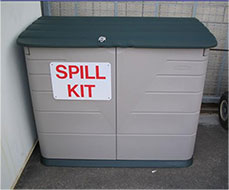
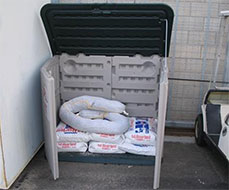
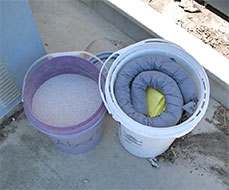
SPCC spill kit images, left to right: large closed spill kit; large open spill kit; small spill kits
Spill response procedures
Be prepared to contain, clean up, and mitigate the effects of an oil spill.
- Safety first! Do not attempt to perform any life or health-threatening acts.
- Try to stop or control the release at the source. (See images below.)
- Use spill kit materials to block flow and prevent discharge into a storm drain.
- Notify EH&S immediately: (858) 534-3660 during business hours. After hours, call UC San Diego Police: (858) 534-4357.
- Build a dike between spill source and drain.
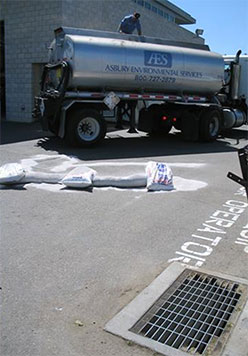
- Use plenty of absorbent.
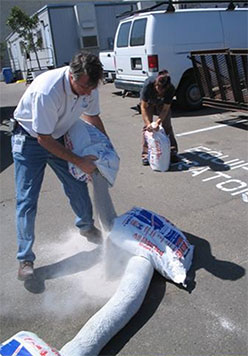
- Absorb the spill.
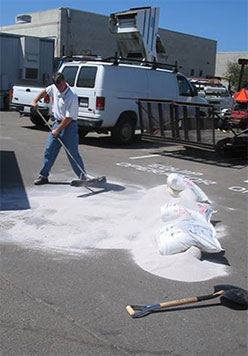
- Surround the drain.
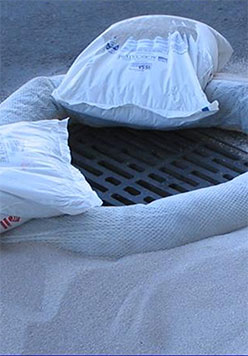
Inspections
Visually inspect oil tanks and containers, systems and equipment, and spill kits on a regular basis.
Examples
Examples of tanks and containers at UC San Diego that must be inspected (and documented) are:
- Waste oil above ground storage tank at Fleet Services
- Emergency generator fuel tanks
- 55-gallon drums of regulated oils (e.g., fuel, hydraulic oil, motor oil, etc.)
- Cooking oil tanks in kitchens and restaurants that contain 55 gallons or more of oil
Inspections requirements
Inspections must be:
- Conducted on a regular schedule (e.g., during routine service or maintenance)
- Performed by someone familiar with the system and equipment
- Documented and signed
What to look for
- Evidence of leaky, worn, or deteriorating transfer lines
- Evidence of leaky valves, rust accumulation on tanks, valves, or lines
- Unsafe conditions that could contribute to a spill (e.g., oil stored in areas of heavy forklift traffic, large unsecured containers)
- Spill kit provisions
Best management practices (BMP)
Follow best management practices (BMP) for outdoor activities that may potentially release oil products into the environment:
- BMP A02: Spill prevention, control, and cleanup (PDF)
- BMP B02: Fueling operations (PDF)
- BMP C05: Food service management (PDF)
Other Site-Specific SPCC Locations
Training requirements
1. SPCC training
Ensure personnel understand the SPCC Plan and receive training that includes:
- Spill response procedures
- System layout, valves, shutoffs, etc.
- Operational procedures
- How to:
- Maintain equipment to prevent leaks and spills
- Visually inspect oil storage locations for spills
- Make sure others follow appropriate delivery and handling procedures
2. Annual hazardous materials training
"Environmental Compliance & Hazards" training is required annually* for non-research employees who work with hazardous materials. This is an eCourse.
How to get the training:
- Complete the Annual Shop & Studio Environmental Compliance & Hazards Training (login required) eCourse on UC Learning Center.
Repeat the eCourse to meet the annual refresher training requirement.
* Expiration dates: San Diego County regulations require training annually – not 12 months from date of completion. Your annual training can be completed anytime this year, regardless of last years expiration date.
Regulations and policies
- Aboveground Petroleum Storage Act, California Environmental Protection Agency (Cal/EPA)
- Oil Spills, U.S. Environmental Protection Agency (EPA) - Rule, 40 CFR Part 112, EPA
- PPM 516-0 Environmental Pollution